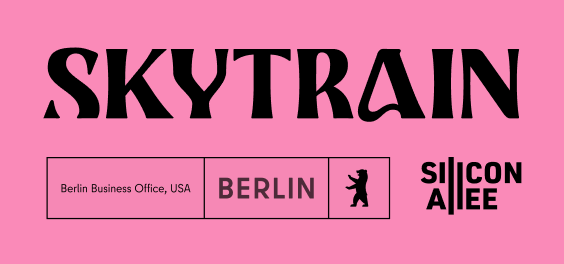This article is published as part of Skytrain – a transatlantic investor community bridging the gap between investors and VC funds in the US and Berlin. Join the network or learn more about what we do here.
Welcome to the crash course in German Venture Capital investment, where we’ll discuss the potential for the perfect storm of opportunity, and why, contrary to popular belief, why it might not be such a bad idea to invest in the German VC ecosystem.
According to a recent report, since 2018, Deutschland’s venture capital market has notably improved, creating a fertile landscape for innovative startups and dynamic young companies to source funding. “But hold on,” you might say, “didn’t we hear something about a persistent financing gap between Europe, including Germany, and the behemoths of the USA and China?”
Well, yes. We can see you’ve been doing your homework.
Even though Germany is upping its game, the financial chasm remains, and worse, the growth we see on the continent is largely thanks to Uncle Sam and his international buddies’ generosity. So, where does that leave us? Well, if you ask us, on the edge of something exciting.
The report outlines how Germany has some serious groundwork ahead to safeguard its economic and technological position. But let’s look at the bright side – German startups are the spry SMEs of tomorrow, and young tech companies are shaping transformation processes. There’s a world of untapped potential here, mainly because Germany and Europe at large have been a tad too shy with their venture capital.
Don’t get us wrong, the resources are there, lurking in the form of European and German pension schemes and private assets. The snag is, these resources aren’t being directed into the channels that promise the best bang for the buck. If only we could convince these folks to take a little risk.
And let’s give some credit to the German government. They’ve got plans, like the Future Financing Act and simplifying immigration for skilled workers, initiatives aimed at sprucing up the startup and venture capital landscape. The trick is to get these measures off the drawing board and into action, pronto.
With organizations like the German Private Equity and Venture Capital Association (BVK), the Internet Economy Foundation (IE.F), Lakestar, and the Schalast Tax | Law practice shining a light on the German venture capital market, we’re making progress. There’s potential here to transform Europe into a global powerhouse. But, of course, it’s going to take some dialogue and engagement from government and market actors.
So, now that you’ve had a taste, are you ready to join the conversation? We’re not just asking you to watch from the sidelines – we’re inviting you to take an active role. After all, the journey of a thousand miles begins with a single step. Or in this case, maybe a few million Euros.
With that in mind, let’s dive into the five things you, as a limited partner, need to know about investing in German Venture Capital.

#1 – Who can invest as an LP?
So, you’re itching to throw your hat into the VC ring in Germany? Well, according to the German Capital Investment Act (Kapitalanlagegesetzbuch – or KAGB for short, because who doesn’t love a good acronym?), there are three types of players in this game:
Institutional (professional) investors: These are the big guns – banks, insurance companies, pension funds, and the like.
They’re regulated, supervised, and have deep pockets. They’re the pros of the market, and they know their way around risks and investments.
For this reason, they only have very limited investor protection. As a rule, they have access to all capital markets and financial instruments, such as special AIFs.
In short, if you don’t know you’re an institutional investor, you’re probably not.
Semi-professional investors: These are the middleweights.
They might not meet all the criteria of a professional investor, but they’ve got enough experience and assets (above €10 million) to play the game. They can commit an initial single investment of at least €200,000 and have enough savvy to be considered experienced.
It includes companies, trusts, foundations, family offices, etc.
Private investors: These are the underdogs, the individuals who don’t fit into the other two categories.
They’re the Angels, the ones who might not have the experience or knowledge to evaluate risk and conduct due diligence effectively. While retail investors also fall into this pot, it’s pretty rare that they have the knowledge and experience to effectively evaluate risk. But don’t worry, the German ‘powers that be’ have laid down laws to protect these investors from losing their shirts due to improper, fraudulent, or misleading information.
That means any VC fund or provider looking to enlist private investors is responsible for providing comprehensive information about the deal, ensuring they meet the customer’s investment objectives, and proving that the investor was able to accurately assess the risk involved and is able to cope with any financial loss if the deal goes south.
Of course, retail investors – due mostly to the level of due diligence and local regulation – have traditionally been excluded from venture capital investment. But more and more alternatives for private investors have been made available over the last few years and democratization of VC is happening fast. We wrote a review of the 10 best software platforms for VC investing, you can check that out here.
Note: the category that an investor is lumped into has to be determined separately for each fund. For example, it may be that an investor is classified as semi-professional for a real estate AIF due to special knowledge and experience in the field of real estate, but does not receive this classification for a VC deal. Further, the access to retail/private investors is combined with regulatory restrictions at fund level.
#2 – What is the minimum LP investment?
If you’re a semi-professional investor, you need to be ready to part with at least €200,000. But fear not. As we mentioned above, there are other ways to dip your toes into the VC pool in Germany – and some of them have a much lower investment hurdle.
Berlin-based provider Moonfare gives investors the opportunity to invest directly in VC funds from the USA with a minimum investment of €50,000.
Asset manager Liqid also offers virtual access to the venture capital asset class. Investors here are currently involved in nine venture capital funds, including Khosla Ventures and Lightspeed. The minimum investment is €20,000.
On our list of the 10 best software platforms for VC investing, we highlight numerous options for private investors to access German VC via Special Purpose Vehicles (SPV) and syndicates starting at a measly €5K.
#3 – What documentation does a fund need from an LP?
As with most things in Germany, there’s no shortage of documentation. The main legal documents for German VC transactions are the investment and the partnership agreement.
The investment agreement includes:
- Pre-money valuation of the company
- Class and price of preferred shares.
- Warranties and representations granted by the founders.
- Cost reimbursement for the VC fund’s legal and other expenses.
The partnership agreement contains::
- Ongoing governance of the company.
- Management retention, in particular ownership of founder shares.
- Employee stock option schemes.
- Anti-dilution provisions.
- Transfer of shares in the investee company including:
- lock-up periods for founders,
- approval rights of investors,
- tag-along and drag along rights.
- Liquidation preference.
Semi-professional investors have to submit a declaration of competence stating that they’re aware of all risks that may be associated with the particular investment.
The AIF management company or appointed sales company are obliged to assess the expertise, knowledge and experience of all LPs. They also have to determine whether you, as the investor, are actually capable of assessing and evaluating all the risks associated with the investment and making a sound investment decision.
For angels investing through SPVs and syndicates. In regulated vehicles you’ll be asked to provide proof that you’re an accredited investor, AML and FATCA forms. You’ll also need to provide proof of source of funds, as well as proving your identity and place of residence or business.
#4 – Who typically eats the transaction fees for foreign transactions?
Well, this is a bit of a ‘who’s on first’ situation. Generally, who pays the transaction fees is up for negotiation and is outlined in the fund’s Limited Partnership Agreement (LPA).
#5 – Do LPs have to file taxes in Germany?
Usually not, but as with all things tax-related, it’s a bit complicated.
If the fund is domiciled in Germany and registered as an asset management fund, it’s tax-transparent, so LPs will only be taxed in their home countries.
But if the fund is registered as a ‘business partnership’, LPs could be subject to trade tax (Gewerbesteuer). So, it’s worth checking to avoid any nasty tax surprises. And remember, when it comes to taxes, it’s always a good idea to consult with a tax professional.
When it comes to VAT, management fees and priority profit share are both exempt.
That being said, it’s important to note that tax implications can be complex and depend on various factors, including the LP’s country of residence and the structure of the fund. So, LPs should always seek advice from a tax professional.
OK so there you have it, 5 Things LPs Need To Know About VC Investing in Germany. We hope that shed a little light into the otherwise dark crevice of the German investment bureaucracy for you. Now for the important legal disclaimer:
We are not lawyers or tax advisors and these articles are not financial advice. Be sure to consult with a lawyer or tax advisor before making any investments. We are, however, happy to recommend some great English-speaking advisors in Berlin.
Article written by Andrew Wilkinson
Join the conversation on twitter:
Interested in joining our transatlantic investor community?

Dieses Vorhaben wurde als Teil der Reaktion der Union auf die Covid-19-Pandemie finanziert.
